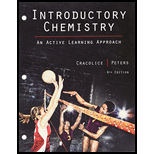
Concept explainers
(a)
Interpretation:
Alkene among the given hydrocarbons is to be identified.
Concept introduction:
Hydrocarbons are the binary compounds that consist of carbon and hydrogen atoms in its structure.
Answer to Problem 21.4TC
Among the given hydrocarbons
Explanation of Solution
According to the general formula of alkenes, for 8 carbon atoms, there must be 16 hydrogen atoms. Hydrocarbon,

According to the general formula of alkenes, for 4 carbon atoms there must be 8 hydrogen atoms, for 7 carbon atoms there must be 14 hydrogen atoms, for 2 carbon atoms, there must be 4 hydrogen atoms. Hydrocarbons
Among the given hydrocarbons
(b)
Interpretation:
The structural formula of trans-difluoroethene
Concept introduction:
Isomers are the compounds which have the same molecular formula but a different structural arrangement of atoms. Alkenes have a double bond between carbon atoms. Due to the presence of a double bond, the rotation about adjacent carbon-carbon atoms is highly restricted. Hence, alkenes can exist in two forms which have the same molecular formula but a different strucutral arrangement of atoms around the double bond. This isomerism is a type of stereoisomerism which is known as geometric isomerism or cis-trans isomerism. In alkenes, when the two similar groups are present on the same side of the double bond is known as cis-isomer and when the two same groups are on the opposite side of the double bond then is known trans-isomer.
In the IUPAC name of an alkene, the Greek prefix represents the number of the substituent, the term before the Greek prefix represents the isomer of the alkene. The suffix for alkene is ‘ene’.
Answer to Problem 21.4TC
The structural formula of trans-difluoroethene

Explanation of Solution
The structural formula of trans-difluoroethene

The structural formula of trans-difluoroethene

(c)
Interpretation:
Concept introduction:
Hydrocarbons are the binary compounds that consist of carbon and hydrogen atoms in its structure. Alkynes are the hydrocarbons that are unsaturated and consist of at least one carbon-carbon triple bond in its structure. The general representation of alkynes is
Answer to Problem 21.4TC
Among the given hydrocarbons
Explanation of Solution
According to the alkynes general formula, for 4 carbon atoms there must be 6 hydrogen atoms and for 7 carbon atoms, there must be 12 hydrogen atoms. Hydrocarbons

According to the alkynes general formula, for 8 carbon atoms there must be 14 hydrogen atoms and for 2 carbon atoms, there must be 4 hydrogen atoms.
Among the given hydrocarbons
(d)
Interpretation:
Straight chain isomers of pentyne and structural formula of
Concept introduction:
Isomers are the compounds which have the same molecular formula but different structural formula. Alkynes are the hydrocarbons that are unsaturated and consist of at least one carbon-carbon triple bond in its structure. The general representation of alkynes is
Answer to Problem 21.4TC
There are two straight chain isomers of pentyne:
![]()
Explanation of Solution
There are two straight chain isomers of pentyne:

There are two straight chain isomers of pentyne:
![]()
Want to see more full solutions like this?
Chapter 21 Solutions
Bundle: Introductory Chemistry: An Active Learning Approach, 6th + OWLv2, 1 term (6 months) Printed Access Card
- draw the alkanes of C7H16, give their structural namearrow_forwardwrite the structure formulas of alkanes with molecular formula C6H14, which with chlorine give: a) three monochlorinated isomers? b) five monochlorinated isomers c) only two monochlorinated isomersarrow_forward7. Give two structural formulas each for poly- and heterofunctional compounds of the composition C4H6O4.arrow_forward
- Draw all possible structure(s) and give the IUPAC systematic name(s) of an alkane or cycloalkane with the formula C8H18 that has only primary hydrogen atoms...arrow_forwardGive the molecular formula of a hydrocarbon containingsix carbon atoms that is (a) a cyclic alkane, (b) a cyclicalkene, (c) a linear alkyne, (d) an aromatic hydrocarbon.arrow_forwardC5H8 has two elements of unsaturation (right?), which may indicate the presence of either double bonds or triple bonds or rings. Show all the possible structuresarrow_forward
- 1. a. Draw and name the five cycloalkane structures of formula C5H10. Can any of these structures give rise to geometric (cis-trans) isomerism? If so, show the cis and trans stereoisomers. b. Draw and name the eight cycloalkane structures of formula C6H12 that do not show geometric isomerism. c. Draw and name the four cycloalkanes of formula C6H12 that do have cis-trans isomers. 2. Each of the following descriptions applies to more than one alkane. In each case, draw and name two structures that match the description. (a) an isopropylheptane (b) a diethyldecane (c) a cis-diethylcyclohexane (d) a trans-dihalocyclopentane (e) a (2,3-dimethylpentyl)cycloalkane (f) a bicyclononane 3. 2. refer to the photo attached and answer the ff.3-33, 3-34arrow_forwardDraw the structure(s) of all of the branched alkene isomers, C6H12, that contain 2 methyl branches.arrow_forwardIs cis,trans isomerism possible in alkanes?arrow_forward
 Chemistry & Chemical ReactivityChemistryISBN:9781133949640Author:John C. Kotz, Paul M. Treichel, John Townsend, David TreichelPublisher:Cengage Learning
Chemistry & Chemical ReactivityChemistryISBN:9781133949640Author:John C. Kotz, Paul M. Treichel, John Townsend, David TreichelPublisher:Cengage Learning Chemistry & Chemical ReactivityChemistryISBN:9781337399074Author:John C. Kotz, Paul M. Treichel, John Townsend, David TreichelPublisher:Cengage Learning
Chemistry & Chemical ReactivityChemistryISBN:9781337399074Author:John C. Kotz, Paul M. Treichel, John Townsend, David TreichelPublisher:Cengage Learning Chemistry: The Molecular ScienceChemistryISBN:9781285199047Author:John W. Moore, Conrad L. StanitskiPublisher:Cengage Learning
Chemistry: The Molecular ScienceChemistryISBN:9781285199047Author:John W. Moore, Conrad L. StanitskiPublisher:Cengage Learning Chemistry: Principles and PracticeChemistryISBN:9780534420123Author:Daniel L. Reger, Scott R. Goode, David W. Ball, Edward MercerPublisher:Cengage Learning
Chemistry: Principles and PracticeChemistryISBN:9780534420123Author:Daniel L. Reger, Scott R. Goode, David W. Ball, Edward MercerPublisher:Cengage Learning
 Introductory Chemistry: A FoundationChemistryISBN:9781337399425Author:Steven S. Zumdahl, Donald J. DeCostePublisher:Cengage Learning
Introductory Chemistry: A FoundationChemistryISBN:9781337399425Author:Steven S. Zumdahl, Donald J. DeCostePublisher:Cengage Learning





